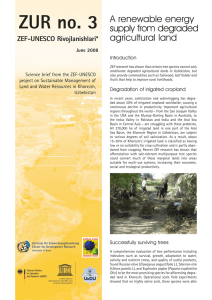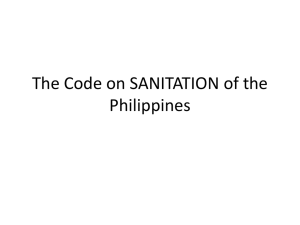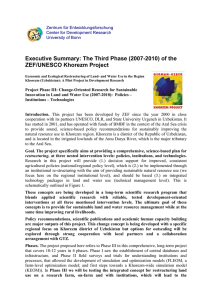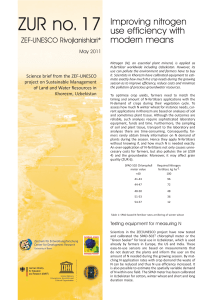ZUR no. 2 0 Water – sanitation –
advertisement
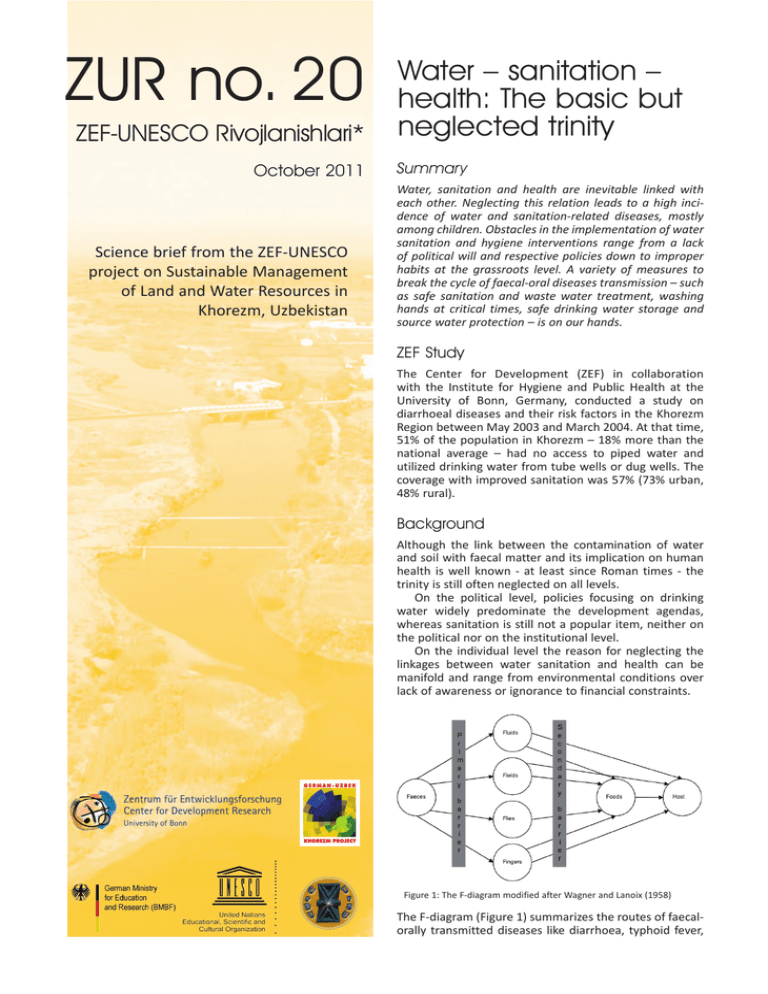
ZUR no. 20 ZEF-UNESCO Rivojlanishlari* October 2011 Science brief from the ZEF-UNESCO project on Sustainable Management of Land and Water Resources in Khorezm, Uzbekistan Water – sanitation – health: The basic but neglected trinity Summary Water, sanitation and health are inevitable linked with each other. Neglecting this relation leads to a high incidence of water and sanitation-related diseases, mostly among children. Obstacles in the implementation of water sanitation and hygiene interventions range from a lack of political will and respective policies down to improper habits at the grassroots level. A variety of measures to break the cycle of faecal-oral diseases transmission – such as safe sanitation and waste water treatment, washing hands at critical times, safe drinking water storage and source water protection – is on our hands. ZEF Study The Center for Development (ZEF) in collaboration with the Institute for Hygiene and Public Health at the University of Bonn, Germany, conducted a study on diarrhoeal diseases and their risk factors in the Khorezm Region between May 2003 and March 2004. At that time, 51% of the population in Khorezm – 18% more than the national average – had no access to piped water and utilized drinking water from tube wells or dug wells. The coverage with improved sanitation was 57% (73% urban, 48% rural). Background Although the link between the contamination of water and soil with faecal matter and its implication on human health is well known - at least since Roman times - the trinity is still often neglected on all levels. On the political level, policies focusing on drinking water widely predominate the development agendas, whereas sanitation is still not a popular item, neither on the political nor on the institutional level. On the individual level the reason for neglecting the linkages between water sanitation and health can be manifold and range from environmental conditions over lack of awareness or ignorance to financial constraints. Zentrum für Entwicklungsforschung Center for Development Research University of Bonn Figure 1: The F-diagram modified after Wagner and Lanoix (1958) The F-diagram (Figure 1) summarizes the routes of faecalorally transmitted diseases like diarrhoea, typhoid fever, cholera, hepatitis A end E. The most effective way to interrupt the faecal-oral disease cycle is to establish primary barriers, which prevent faecal pollution of the environment. This includes safe emptying techniques for septic tanks and latrines, safe disposal of faecal matter, intact wastewater infrastructure, effective wastewater treatment and hand washing after contact with faecal matter. of the environment with faecal-oral pathogens should be the first choice. This includes upgrading the sanitary infrastructure, the protection of water sources and the change of water, sanitation and health-related behavior. Possible measures are: • Upgrading sanitary infrastructure in the public and the private domain. • Eliminating open defecation by children and safe disposal of children’s excreta. • Introducing hygienically safe pit emptying techniques, hygienically safe nutrient recycling such as sustainable sanitation and domestic wastewater disposal. • Improving the protection of water sources by keeping safety distances between latrines and wells, providing dug wells with covers and avoiding priming in hand pumps. Figure 2: Unprotected dug well with mushrooms growing on brick wall Situation According to the fact that about half of the population in Khorezm utilize piped water from water works and taking into account official diarrhoea incidence rates and microbiological water quality data, it was assumed that a statistical association between the drinking water source and the number of diarrhoea episodes per household might be observed. Surprisingly, the number of diarrhoea cases was not statistically associated with drinking water quality at the point of its source, but with visible contamination of the drinking water storage vessels and the absence of hygiene materials in the toilet/latrine. Furthermore, a tremendously high incidence of diarrhoeal diseases, in particular among children under two years of age could be observed during all seasons. Based on their statistical results and observations the researchers concluded that faecal pollution of the environment is mainly caused by a lack of public sewerage systems and wastewater treatment as well as practices such as: Deposing children’s faeces on the compounds, open defecation of small children, fertilizing vegetable gardens and arable with fresh human faecal matter, discharging faecal matter into surface waters. These practices subsequently lead to a pollution of water sources and stored drinking water with faecal-oral pathogens. Furthermore, water and sanitation-related hygiene habits in the domestic domain play a major role in transmitting diarrhoeal diseases in Khorezm. To achieve safe disposal of wastewater and protection of drinking water sources, it is necessary to act on different levels by introducing respective policies and behavior change programs in order to break faecal-oral disease transmission Recommendations Based on the understanding that water and sanitation are two sides of the same coin, measures establishing a primary barrier and therefore preventing contamination • Introducing hygiene and health education comprising the explanation of causes and prevention of disease, personal hygiene, strategies on safe drinking water handling from source to consumption, strategies to prevent faecal contamination of the environment and proper management of childhood diarrhoea. Healthhygiene education for young children is known to be very effective in the long-run, because children do both; having impact on their families and acting as future role models. Reference Herbst S (2006). Water, sanitation, hygiene and diarrhoeal diseases in the Aral Sea area (Khorezm, Uzbekistan). Ecology and Development Series No. 43. Cuvillier Verlag, Göttingen, Germany. Herbst S, Fayzieva D, Kistemann T (2008). Risk factor analysis of diarrhoeal diseases in the Aral Sea area, (Khorezm, Uzbekistan). Int J Environ Health Res 18 (5):305-321. Figure 1: Wagner E. G. und Lanoix J. N. 1958: Excreta disposal for rural areas and small communities. Geneva, WHO. IMPRINT Author: Susanne Herbst The author has been affiliated with the ZEF/UNESCO project in Uzbekistan. Editor: Alma van der Veen (ZEF) * ZUR is an abbreviation of ZEF-UNESCO Rivojlanishlari, meaning ZEF-UNESCO Developments. The ZUR science briefs publish scientific project output with policy relevance on a regular basis. Published by the Center for Development Research (ZEF) University of Bonn, Germany Uzbekistan Project Office phone: # 49 228 731917 or 734924 e-mail: khorezm@uni-bonn.de homepage:http://www.khorezm.zef.de/ ZUR no. 20 October 2011
